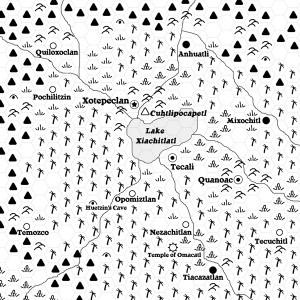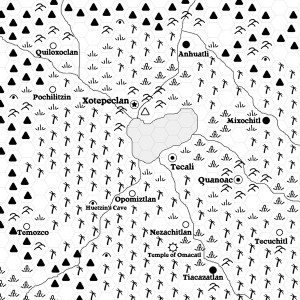 Much has been discussed about the inhabitants, both human and otherwise, of Tlactoztlan. But so far, little has been revealed of its nature. Below are some verbal sketches of the nine lessser Tlactozotl cities as well as an indication of things that are frequently seen in those cities.
Much has been discussed about the inhabitants, both human and otherwise, of Tlactoztlan. But so far, little has been revealed of its nature. Below are some verbal sketches of the nine lessser Tlactozotl cities as well as an indication of things that are frequently seen in those cities.
The current map of Tlactoztlan is reproduced here for reference. Click on it for a larger version.
Anhuatli
Anhuatli has a thriving “secular” university, the library of which nearly rivals that of the Great School in Xotepeclan. Students who attend this college are often the children of lesser nobles or scions of the larger merchant families of Tlactoztlan. Philosophy, the arts and sciences, and even outlander languages are taught here by a faculty comprised largely of Tlactozotl who have returned to the hidden valley after traveling in the wider world. The religious leaders of Tlactoztlan grudgingly tolerate the presence and organization of these “heretics” only because King Cuhuitlazcaltiacapan insists that at least some number of Tlactozotl have an understanding of the greater world because it is necessary to understand one’s enemies. The occasional too-outspoken teacher has run afoul of the priesthood in the past, though.
- A group of students returning from a “field trip” to the outside world, weary but excited
- A heated debate between visiting priests and multiple professors in the public market
- Farmers from the outlying areas delivering goods, aghast at the fashions and attitudes of Anhuatli
- Children of the faculty of the University openly taunting priests as they travel through the city
- A group of Eagle Knights eyeing a small band of visiting Jaguar Warriors suspiciously
Mixochitl
Renowned for its natives’ outstanding and colorful wooden animals and demons, Mixochitl is the capital of the “lesser” arts such as wood carving and basket making. The people of Mixochitl are humble and honest, shunning the bright colors favored by most other Tlactozotl. The food here is simple yet exquisite fare, featuring corn fritters filled with various savory and sweet delights. Mixochitlotl are capable of great warmth and generosity, but are often wary of outsiders when they are first encountered.
- Artisans selling their carved wood creatures along the main thoroughfare
- Women selling food from traveling carts pulled by their excited children
- A scarred old warrior wrestling an crocodile in a pit for money
- Small groups of young women gathered about the fountain in the town square, coyly flirting with passersby
- An Jaguar Warrior attempting to recruit disaffected townsfolk into his order
Tiacazatlan
Home to numerous temples to lesser Tlactozotl deities, Tiacazatlan is a mecca for those with simpler needs and humbler requests. Tiacazatlan also benefits from a number of mineral springs which draw visitors from throughout Tlactoztlan.
- Water merchants selling elixirs and draughts, some of which may have magical or healing properties
- A farmer waiting at the steps of the temple of Xilonen in hopes of receiving a blessing
- Priests of the lesser deities leaded in the old and infirm to temple for use as sacrifices
- A circus with jugglers, fire eaters and trained jaguars performing in the central plaza
- A group of young Jaguar Warriors training near the outskirts of the city
Quiloxoclan
A very serious place indeed, Quiloxoclan is home to the finest weapon-makers in all of Tlactoztlan. Obsidian from the nearby mines is somehow stronger and sharper than that found elsewhere in the lost valley. The people of Quiloxoclan are all devout followers of Itzlacoliuhque, the Tlactozotl god of obsidian knives and other implements of war.
- Merchants displaying their finely crafted macuahuitl and obsidian knives, sometimes in elaborate weapon skill exhibitions put on by the local Eagle Knights
- Priests of Itzlacoliuhque inspecting the workshops of weapon-makers to ensure that the crafters are meeting the standards set by the priesthood
- A group of outlanders who have found their way into the lost valley via one of the rivers that runs through the nearby mountains
Pochilitzin
At the foot of Topecacalpachipan, the second tallest peak in the western mountains, stands Pochilitzin, the City of Feathers. The combination of terrain types near Pochilitzin allows for a broad range of bird species to be found within easy traveling distance, which in turn makes the town the ultimate resource for the feathers that feature so prominently in Tlactozotl clothing and art. The feathers that comprise the headdresses of many nobles and priests were originally purchased in the markets in Pochilitzin.
- Feather merchants hawking their wares
- A group of bird hunters returning with a great catch of condor, parrot and hawk
- Priests of Opochtli blessing a hunting party about to set out
Temozco
Called “Little Quanoac” by many Tlactozotl, Temozco lies nestled at the base of Nezahuaquitzin, the tallest mountain in the west. Like Quanoac, Temozco is a thriving mercantile and artisan stronghold. The priests of Tlaloc maintain an extravagant temple here, and in return for the loyalty of the Temozcozotl they intercede with the armies of King Cuhuitlazcaltiacapan, keeping the city free of unwanted political interference.
- Ladies selling pottery and beaded necklaces along the main thoroughfare
- Priestesses of Xochiquetzal leading a sacrifice to bring good fortune to the Temozcozotl artisans
- A seller of trained monkeys visiting the city from the deep jungle to the north
Opomiztlan
The premier headdress makers of Tlactoztlan – Xiuixico, Pizcazatec, and Maloxoq – make their homes in Opomiztlan, just close enough to the great cities to be accessible to the young nobles who flock to them for their artistry and just far enough away that they can actually focus on their art. Life among the Opomiztlotl is marked with frivolity and an obsession with appearances. The food in Opomiztlan is very spicy and focuses heavily on fish-based dishes.
- An impromptu fashion show pitting the latest creations of the great headdress houses against one another for the amusement of the local Priestesses of Ayauhteotl
- A group of young nobles visiting one of the headdress makers to deliver their rite-of-passage feathers for the creation of their own unique headdresses
- The hermit Huetzin passing though town gathering supplies for the coming season
Nezachitlan
Nezachitlan is home to the largest and most prestigious Ullamaliztli court in Tlactoztlan, even grander and more storied than the ones in Xotepeclan, Tecali and Quanoc. The people of Nezachitlan are justifiably proud of their long history of dominance on the tlachtli and take their local team’s performance very seriously. The town’s guard is always on patrol for jaguar-masked minions of Tlilpotonqui sneaking through the town at night in search of drunken revelers, destitute gamblers, and other questionable individuals to use as part of the never-ending tide of sacrifices at the Temple of Omacatl, which lies not far to the southwest.
- A recently victorious Ullamaliztli team being paraded through the streets
- A group of gamblers outside the arena placing bets on upcoming matches
- Tlilpotonqui himself visiting the town simply to reinforce the people’s fear of him
Tecuchitl
Travelers to remote Tecuchitl are frequently surprised to discover a vibrant and thriving town where nothing more than a village would be expected. The Tecuchitlotl wouldn’t have it any other way. These hardy and clever souls are quite happy to remain on the empire’s edge, pushing the boundaries of esoteric wisdom and arcane lore without the involvement of the priests, soldiers and politicians so prevalent in the rest of Tlactoztlan.
- A group of Izatacli renewing the enchantments that render the town nigh invisible to the rest of Tlactoztlan
- Alchemists and apothecaries intensely creating talismans and concoctions in the Xiuhitl, an open air marketplace for such oddities
- Sorcerers from outside the lost valley who have come to confer with the great sages who reside here, largely free to pursue their goals in peace



